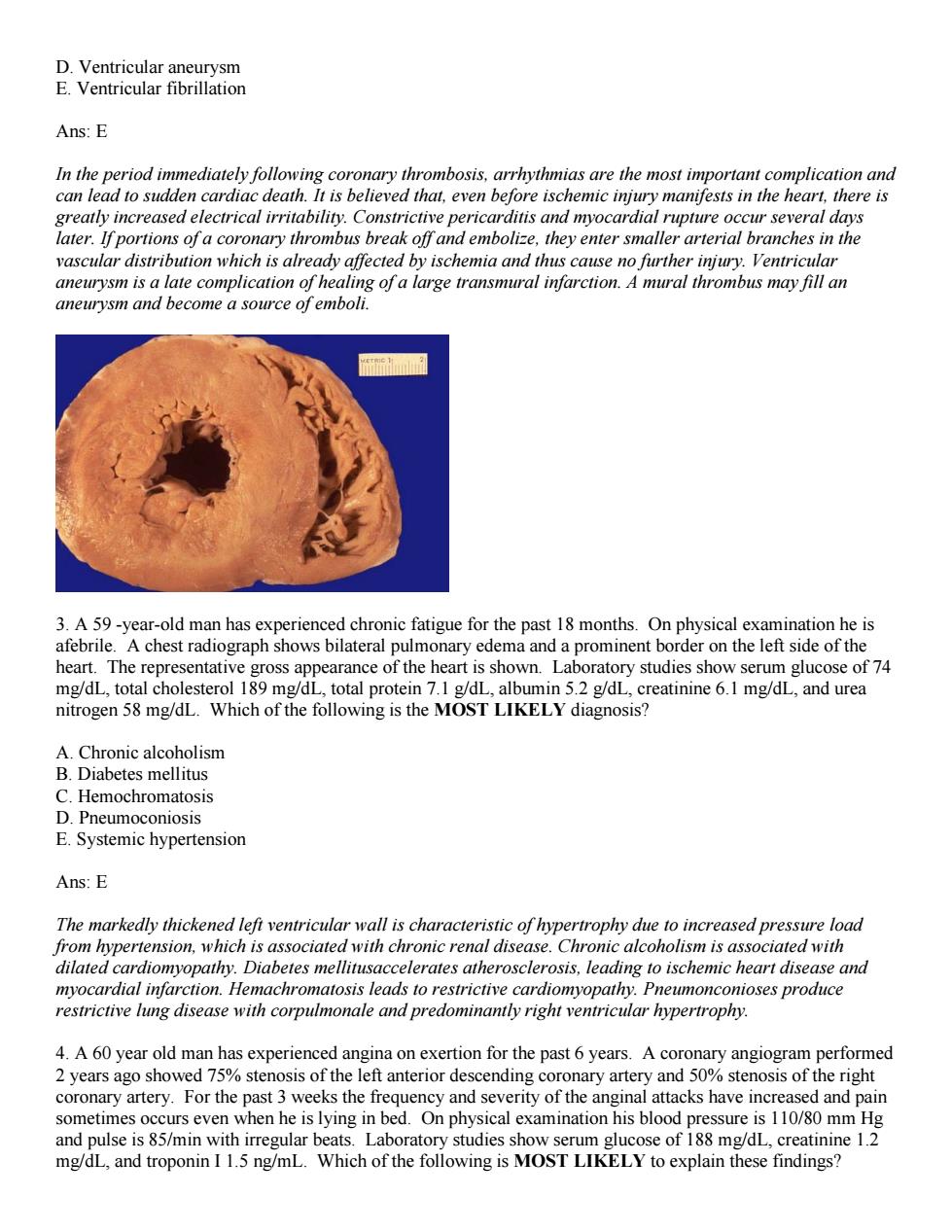正在加载图片...

Ans:E In the period immediately following coronary thrombosis.arrhythmias are the most important complication and can lead to sudden cardiac death.It is believed that,even before ischemic injury manifests in the heart,there is greatly increased electrical irritability.Constrictive pericarditis and myocardial rupture occur several days later.Ifportions of a coronary thrombus break off and embolize,they enter smaller arterial branches in the vascular distribution which is already affected by ischemia and thus cause no further injury.Ventricular aneurysm is a late complication of healing of a large transmural infarction.A mural thrombus may fill an aneurysm and become a source of emboli. 3.A59-year-old man has experienced chronic fatigue for the past 18 months.On physical examination he is afebrile.A chest radiograph shows bilateral pulmonary edema and a prominent border on the left side of the heart.The representative gross appearance of the heart is shown.Laboratory studies show serum glucose of 74 mg/dL,total cholesterol 189 mg/dL,total protein 7.1 g/dL,albumin 5.2 g/dL,creatinine 6.1 mg/dL,and urea nitrogen 58 mg/dL.Which of the following is the MOST LIKELY diagnosis? A.Chronic alcoholism B.Diabetes mellitus C.Hemochromatosis D.Pneumoconiosis E.Sy stemic hypertension Ans:E with ch onic ren e. etes mellitus lerates atherosclerosis,lead ing to ischemic heart disease and myocardial infarction.Hemachromatosis leads to restrictive cardiomyopathy.Pneumonconioses produce restrictive lung disease with corpulmonale and predominantly right ventricular hypertrophy. 4.A 60 year old man has experienced angina on exertion for the past 6 years.A coronary angiogram performed 2 years ago showed 75%stenosis of the left anterior descending coronary artery and 50%stenosis of the right coronary artery.For the past 3 weeks the frequency and severity of the anginal attacks have increased and pain sometimes occurs even when he is lying in bed.On physical examination his blood pressure is 110/80 mm Hg and pulse is 85/min with irregular beats.Laboratory studies show serum glucose of 188 mg/dL,creatinine 1.2 mg/dL,and troponin I 1.5 ng/mL.Which of the following is MOST LIKELY to explain these findings?D. Ventricular aneurysm E. Ventricular fibrillation Ans: E In the period immediately following coronary thrombosis, arrhythmias are the most important complication and can lead to sudden cardiac death. It is believed that, even before ischemic injury manifests in the heart, there is greatly increased electrical irritability. Constrictive pericarditis and myocardial rupture occur several days later. If portions of a coronary thrombus break off and embolize, they enter smaller arterial branches in the vascular distribution which is already affected by ischemia and thus cause no further injury. Ventricular aneurysm is a late complication of healing of a large transmural infarction. A mural thrombus may fill an aneurysm and become a source of emboli. 3. A 59 -year-old man has experienced chronic fatigue for the past 18 months. On physical examination he is afebrile. A chest radiograph shows bilateral pulmonary edema and a prominent border on the left side of the heart. The representative gross appearance of the heart is shown. Laboratory studies show serum glucose of 74 mg/dL, total cholesterol 189 mg/dL, total protein 7.1 g/dL, albumin 5.2 g/dL, creatinine 6.1 mg/dL, and urea nitrogen 58 mg/dL. Which of the following is the MOST LIKELY diagnosis? A. Chronic alcoholism B. Diabetes mellitus C. Hemochromatosis D. Pneumoconiosis E. Systemic hypertension Ans: E The markedly thickened left ventricular wall is characteristic of hypertrophy due to increased pressure load from hypertension, which is associated with chronic renal disease. Chronic alcoholism is associated with dilated cardiomyopathy. Diabetes mellitusaccelerates atherosclerosis, leading to ischemic heart disease and myocardial infarction. Hemachromatosis leads to restrictive cardiomyopathy. Pneumonconioses produce restrictive lung disease with corpulmonale and predominantly right ventricular hypertrophy. 4. A 60 year old man has experienced angina on exertion for the past 6 years. A coronary angiogram performed 2 years ago showed 75% stenosis of the left anterior descending coronary artery and 50% stenosis of the right coronary artery. For the past 3 weeks the frequency and severity of the anginal attacks have increased and pain sometimes occurs even when he is lying in bed. On physical examination his blood pressure is 110/80 mm Hg and pulse is 85/min with irregular beats. Laboratory studies show serum glucose of 188 mg/dL, creatinine 1.2 mg/dL, and troponin I 1.5 ng/mL. Which of the following is MOST LIKELY to explain these findings?